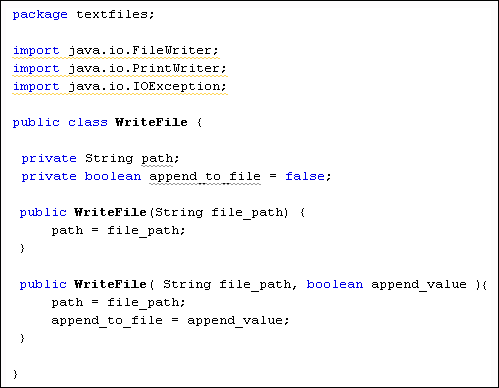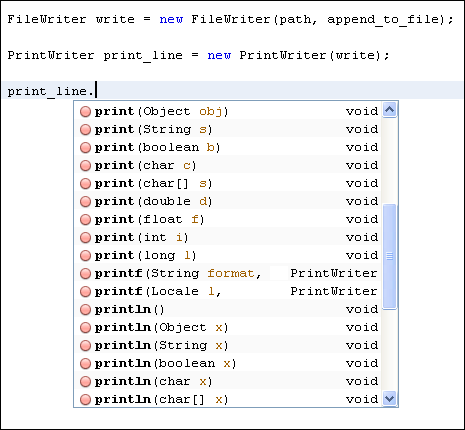Writing to a file is a little easier than reading a file. To write
to a file, we'll use two more inbuilt classes: the
FileWriter
class and the
PrintWriter class.
Create a new class in
your project
by clicking
File > New File from the NetBeans menu. Select
Java in the Categories section of the dialogue box and
Class
from the File Types list. Click the Next button at the bottom. For the
Class name type
WriteFile, then click Finish. Add the following
three import statements your new code:
import java.io.FileWriter;
import java.io.PrintWriter;
import java.io.IOException;
Your new class should look like this:
Again, the underlines are because we haven't used the imported classes
yet.
When you write to a file, you can either start from the beginning and
overwrite everything. Or you can start at the end and append to the
file. The FileWriter class allows you to specify which. We'll add a
field that sets the append value for the FileWriter class. We'll also
add a field to set the name of the file.
So add the following two fields to your code, plus the constructor:
The boolean field is called
append_to_file and has been set
to a value of
false. This is the default value for the FileWriter
class, and means you don't want to append, but erase everything in the
file.
The constructor sets a value for the
path field (instance variable),
which is the name and location of the file. This will get handed over
when we create a new object from our WriteFile class.
As was mentioned in the previous section, however, you can set up more
than one constructor in your code. We can set up a second one and pass
in an append value. That way, a user can either just use the first constructor
and hand over a file name, or a file name and an append value. So add
the following constructor below the first one:
public WriteFile( String file_path , boolean
append_value ) {
path = file_path;
append_to_file = append_value;
}
This second constructor now has two values between the round brackets,
a file path and an append value. If you want to append to the file you
can use this constructor when creating a new object. If you just want
to overwrite the text file then you can use the first constructor.
Your code window should now look like this:
To write to the file, add the following method below your two constructors:
public void writeToFile( String textLine
) throws IOException {
}
This method doesn't need to return a value, so we've made it void.
In between the round brackets of the method name we have a String variable
called
textLine. This is obviously the text we want to write
to the file. Again, though, we need to add "throws IOException"
as we need to do something to handle file-writing errors.
The first thing we need in the method is a FileWriter object. The FileWriter
takes care of opening the correct file, and of storing the text as bytes.
Add the following line to your writeToFile method:
FileWriter write = new FileWriter( path , append_to_file);
So we're creating a new FileWriter object with the name write. In between
the round brackets of FileWriter we pass the name and location of the
file, plus the append value. This will either be
true (append
to the file) or
false (don't append). If a file of the name you
pass over does not exist, the FileWriter creates one for you.
The FileWriter write bytes, however. But we can hand the FileWriter
plain text with the aid of the
PrintWriter class. The PrintWriter
has a few handy print methods for this. But it needs the name of a FileWriter
when creating the object from the class. So add this line to your method:
PrintWriter print_line = new PrintWriter( write
);
Our PrintWriter object is called print_line. In between the round brackets
of PrintWriter, we've added the name of our FileWriter object.
To add the text to a file, type the name of the PrintWriter object
followed by a dot:
print_line.
As soon as you type the dot, NetBeans will display a list of available
options:
There are an awful lot of print options on the list!
The one we'll use is one of the
printf methods. This allows
you to pass a formatted string of text to your PrintWriter. A good reason
for using printf is to handle new line characters. The new line character
differs, depending on which operating system you use. Windows will add
the characters \r\n for a new line. But Unix systems just use \n. Using
the printf function will ensure the correct encoding, no matter what
the platform.
Add the following line to your code:
print_line.printf( "%s" + "%n"
, textLine);
We've handed the printf method two things: a format for the text, and
the string we want to write to the file. The two are separated by a
comma. Notice the first of the two:
"%s" + "%n"
The %s between double quotes means a string of characters of any length.
The %n means a newline. So we're telling the printf method to format
a string of characters and add a newline at the end. The actual text
that needs formatting goes after the comma. The printf method is quite
useful, and we'll go through the options in more detail in a later section.
For now, let's crack on.
Only one more line to add to your method:
print_line.close();
This line closes the text file and frees up any resources it was using.
Your WriteFile class should now look like this:
To test out your new class, go back to your FileData class (the one
with the main method). Add the following line to create a new object
from your WriteFile class:
WriteFile data = new WriteFile( file_name ,
true );
So we've set up a WriteFile object called data. In between the round
brackets of WriteFile, we've added two things: the name of the file,
and an append value of true. This will ensure that the second of the
constructors we set up gets called. If we wanted to just overwrite the
file, then the code would be this:
WriteFile data = new WriteFile( file_name );
Because we set the default append value as false, we only need the
file name if we want to overwrite the entire contents.
To call the writeToFile method of your WriteFile object, add this line:
data.writeToFile( "This is another line
of text" );
Feel free to change the text between the round brackets of the method.
To let the user know that something has happened, you can print something
to the Output window:
System.out.println( "Text File Written
To" );
Your
FileData code should now look like this (we've added some
comments):
If you like, add another
try … catch part for your text
writing. Instead of the above, change it to this:
Now run your code to test it out. You should see the contents of your
text file in the Output window followed by the message that the text
file has been written to:
Run the programme again and you should see the new line appear. (You
can comment out the code that writes to the text file.)
And that's it - you can now write to a text file and read its contents.
In the next section, we'll move on and tackle programming with Java
Forms.








